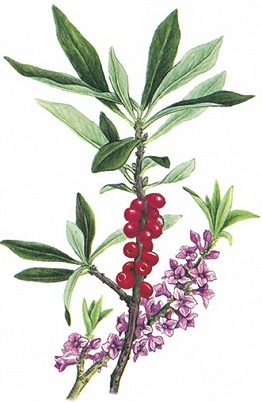Traditional methods (ethnoscience) of treatment of epilepsy.
Since ancient times, people have widely used natural resources, sometimes trying to find salvation in them from any ailments – the history of herbal treatment was written parallel to the history of mankind. Information about medicinal plants was passed down orally from generation to generation, later observations began to be recorded on clay tiles, papyri, in books. The healing properties of various herbs were discovered gradually, knowledge was accumulated and systematized. After centuries of testing, some remedies and methods of treatment have earned universal recognition and have survived to this day in the arsenal of remedies.
In folk medicine, many anticonvulsant and antiepileptic plants have been used for centuries, the effects of which also included antimicrobial, anti-inflammatory, diuretic, sedative effects.
Epilepsy is a neurological condition that, from time to time, gives rise to brief disturbances in the normal electrical function of the brain. Normal brain function can make millions of tiny electrical charges flowing between nerve cells in the brain and to all parts of the body. When someone suffers from epilepsy, this normal pattern may be interrupted by intermittent bursts of electrical energy that are much more intense than usual. It can affect a person’s consciousness, bodily movements and sensations for a short time.
These physical changes are called epileptic seizures. Unusual bursts of energy can occur in only one area of the brain (partial seizures), or can affect nerve cells throughout the brain (generalized seizures). Normal brain function cannot return until the electrical flares subside. The conditions in the brain that produce these episodes may be present from birth, or they may develop later in life due to trauma, infection, structural damage to the brain, exposure to toxic agents, or for reasons that are still not fully understood. Many illnesses or severe injuries can affect the brain quite strongly. If the seizures continue for unknown reasons, or because an underlying problem cannot be corrected, the condition is known as epilepsy. Epilepsy affects people of all ages, all nations, all races.
Traditional methods: Daphne mezereum.

20-30 g of Daphne mezereum root is brewed in 50-100 g of water, insisted for 20 minutes and 5 g are taken for epilepsy and as a very effective sleeping pill, from which an extremely sound sleep occurs.
Scientific research
Many researchers and doctors believe that the use of herbs in the treatment of epilepsy helps to improve mood, eliminate neurotic manifestations in the form of increased fatigue, irritability, anxiety, and fears. Providing a general strengthening effect, herbal medicine helps to expand the patient’s adaptation capabilities, significantly reducing the destructive effect of stress. In addition, individually selected herbal preparations help to correct the patient’s condition, not only eliminating the side effects of drugs, but also relieving the patient from other, so-called concomitant diseases, which, in turn, has a beneficial effect on the course of epilepsy.
Dr. Bekhterev proposed the use of certain cardiovascular medicinal substances to eliminate vascular disorders in a convulsive attack. In the course of treatment, in a mixture with bromides, the following were used: Adonis vernalis, digitalis, convalaria majalis, etc. Over time, preference was given to Adonis vernalis as the most effective remedy. Ankylosing spondylitis was created, which is widely used in the treatment of epilepsy. It contains: infusion of spring adonis herb 6.0: 180.0, codeine phosphate 0.2 g, sodium bromide 6.0 g. Dr. Bekhterev noted that epileptic seizures are accompanied by tachycardia, even if common seizures are not observed. Tachycardia is also observed in the form of an aura, which is exactly what is remembered by patients who an attack. Thus, tachycardia is one of the persistent symptoms of epilepsy, which has been suggested to play a role in its pathogenesis. In addition, Dr. Bekhterev expressed the idea of the advisability of prescribing cardiac drugs for the treatment of epilepsy in order to influence the enhancement of the excretion of “unusable products of liver metamorphosis” and on the regulation of cerebral vessels.
Currently, there are many schemes for the treatment of epilepsy, the selection of which is carried out by specialists individually. The following plants are most commonly used in combinations:
- Calamus ordinary (calamus marsh), Acorus calamus L. (Aroid family)
- Mountain arnica, Arnika montana L. (Compositae family)
- Spotted hemlock, Conium maculatum L. (Umbelliferae family)
- Valerian officinalis, Maun officinalis, Valeriana officinalis L. (Valerian family)
- Oregano, Origanum vulgare L. (Family Labiata)
- Angelica officinalis, Arclangelica officinalis Hoffm. (Syn. Angelica Archangelica L.), (Families about umbrella)
- St. John’s wort (common), Hypericum perforatum (Family St. John’s wort)
- Lemon balm, Melissa officinalis L. (Family Labiata)
- Evasive peony, P. anomala L.
- Motherwort, L. cardiaca L.
- Chamomile, Matricaria Chamomilla L. (Compositae family)
- 12.Chernobylnik, Artemisia vulgaris L. (Compositae family)
- Sage officinalis, Salvia officinalis L. (Labiate family)
Vitamins and minerals for epilepsy
Vitamin and mineral complexes are especially necessary for young children or people on a ketogenic diet. With epilepsy, the patient has limited nutrition, which negatively affects physical and mental development. What vitamins and minerals restore the body’s work:
- Vitamins of group B. For a healthy metabolism and energy, the body needs folic acid, B6 and B12 – they eliminate drug resistance.
- Vitamin D. In epileptics, the liver actively produces enzymes that flush vitamin D out of the body. Calcium deficiency threatens osteoporosis.
- Antioxidants Taking medications reduces the amount of selenium, vitamins C and E, therefore, the use of antioxidants is included in the medication course.
- Magnesium. It is necessary to maintain the balance of neurotransmitters, as well as to inhibit calcium channels.
- Melatonin. It inhibits excitatory receptors and glutamate, helps to restore sleep and the biological rhythm of life, gives strength and energy.
- Omega – 3. Fatty acids are indispensable for epilepsy due to their anticonvulsant effect. The high amount of fat in the blood stimulates the production of ketone, which replaces the excitatory glucose, but is not harmful.
